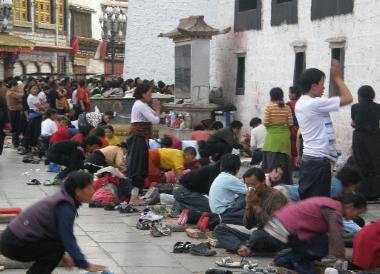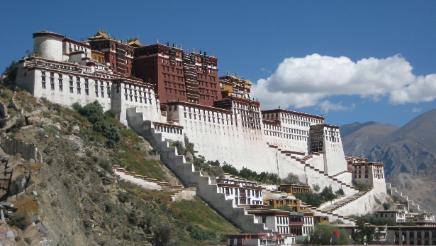|
|
Jarrod and I tempered our expectations of Tibet after hearing many people lament that the Chinese invasion
and infiltration have ruined the Tibetan culture. But we didn’t buy into this condemnation wholeheartedly enough to
skip a trip to Tibet. There was still enough allure about the ancient, peaceful civilization secluded high above the
rest of the world for us to willingly subject ourselves to a 47-hour train ride across China’s western plains. As the
train climbed higher and higher we saw fewer rice fields and more and more yaks. The dry and dusty plains gave
way to frigid tundra dotted with small lakes with snow covered mountains looming on the horizon.
|
|
|
|
We arrived after dark in Lhasa, the former
capital of Tibet and the home of the Dalai Lama
before he fled to India after the Chinese invasion in
1959. We made it to our hotel and fell into bed,
grateful to be sleeping somewhere that wasn’t
moving. The next morning we stepped out of our
hotel and were immediately swept up into the river of
chanting Tibetan Buddhists making their pilgrimage
around the Jokhang Temple. Everyday hundreds of
them circle the temple, praying, chanting, swinging
prayer wheels and performing full body prayer
prostrations. The scene is truly mesmerizing and the
buzz of these pilgrims’ voices creates a palpable
energy. We gladly joined in the progression and let
the tide carry us to the front of Jokhang Temple
where many pilgrims stopped to worship. We stepped
out of the flow to observe for a few minutes, and
noted how many of these pilgrims still wear
traditional Tibetan clothing. The women’s clothes
were the most mesmerizing. They wore full-length
|
|
|
|
 |
|
|
|
|
|
Tibetan Buddhist pilgrims performing prayer prostrations in front
of Jokhang Temple.
|
|
|
|
|
|
dark dresses, but over these dark dresses they wore vividly striped aprons of silk. Their ears, neck, fingers, and
wrists were adorned with heavy antique silver and turquoise jewelry and their long, dark hair was worn in braids,
often threaded throughout with red ribbon. In addition to their brilliant clothing, the complexion of Tibetans is
something to be envied. Their smooth, almond colored faces are happily accentuated with rosy red cheeks, giving
them a healthy, energetic look at all times.
We spent several days learning about Tibetan Buddhism and the history of the country by visiting some of the
major sights around Lhasa. Jokhang Temple is the spiritual center of Tibet. Everyday pilgrims from every corner of
the country trek a long distance to the temple. Some devout pilgrims even make the journey from their home to the
temple door by means of full body prayer prostrations, which consist of taking one step toward the temple and
then laying flat on the ground face down in complete prayerful submission. Then they stand up and repeat the
process one step ahead of where they prostrated themselves last. As you can imagine, this is not a quick or easy
means of pilgrimage. Once at Jokhang Temple pilgrims honor their deities with white scarves (Kha-btags or Hada)
while murmuring sacred mantras to show their pieties to the Buddha. It is a fascinating event to witness.
Sometimes it felt sacrilegious to be vacationing in the same place these pilgrims were experiencing one of the most
spiritual moments of their life.
|
|
|
|
 |
|
|
|
Lhasa’s other main attraction is Potala
Palace. The Potala Palace was home to the
Dalai Lama until the 14th Dalai Lama was
forced to flee to India after China invaded
Tibet. The Palace has now been converted
into a museum by the Chinese. I cannot
fathom what the Palace would be like if the
Dalai Lama still lived there. Even without a
soul residing there the place exudes
spirituality. Walking through the various
chapels, halls and living quarters of the
Dalai Lamas the power of Tibetan Buddhism
is deeply felt. Not to mention the
magnificence of the Potala Palace from the
outside as it rises above the city of Lhasa.
|
|
|
|
|
|
Potala Palace, the former home of the Dalai Lama in Lhasa, Tibet
|
|
|
|
return to tibet overview next tibet journal >
|
|
|
|
|
|
|
|

